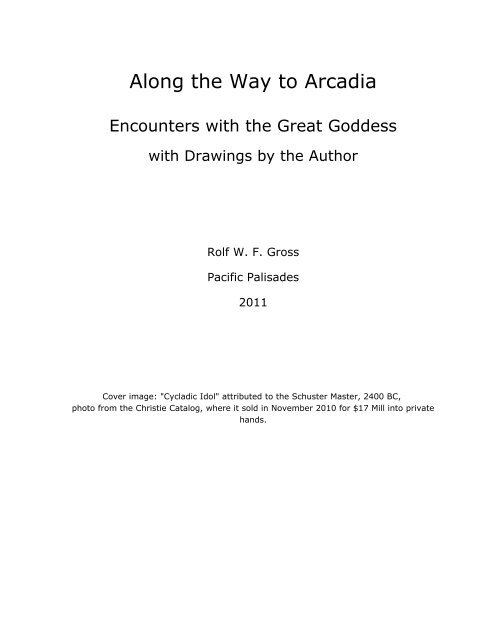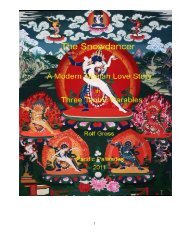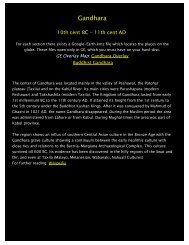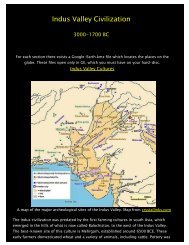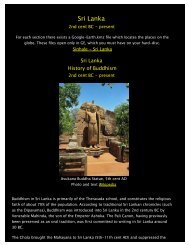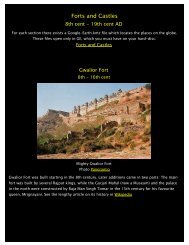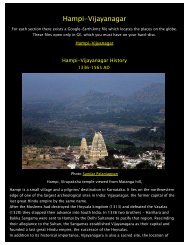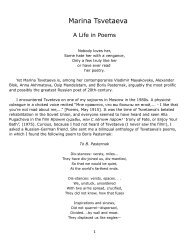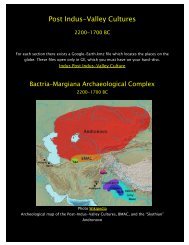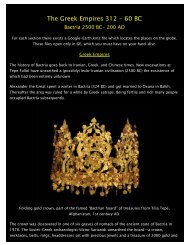On the Way to Arcadia (PDF) - Rolf Gross
On the Way to Arcadia (PDF) - Rolf Gross
On the Way to Arcadia (PDF) - Rolf Gross
Create successful ePaper yourself
Turn your PDF publications into a flip-book with our unique Google optimized e-Paper software.
Along <strong>the</strong> <strong>Way</strong> <strong>to</strong> <strong>Arcadia</strong><br />
Encounters with <strong>the</strong> Great Goddess<br />
with Drawings by <strong>the</strong> Author<br />
<strong>Rolf</strong> W. F. <strong>Gross</strong><br />
Pacific Palisades<br />
2011<br />
Cover image: "Cycladic Idol" attributed <strong>to</strong> <strong>the</strong> Schuster Master, 2400 BC,<br />
pho<strong>to</strong> from <strong>the</strong> Christie Catalog, where it sold in November 2010 for $17 Mill in<strong>to</strong> private<br />
hands.
My path <strong>to</strong> Dokhathismata blocked by <strong>the</strong> Goddess<br />
The Great Goddess<br />
To Marija Gimbutas,<br />
hoping that she will allow<br />
a man <strong>to</strong> pursue her Goddess<br />
<strong>On</strong> my 60th birthday Barbara, my wife, gave me a Cycladic Woman. A modern copy, which she<br />
had found in A<strong>the</strong>ns, but an exceptionally beautiful one. She lies under <strong>the</strong> glass table in our<br />
living room. A year later we went <strong>to</strong> look for her on <strong>the</strong> island of Amorgos in <strong>the</strong> Aegean Sea.<br />
We never found <strong>the</strong> cemetery of Dokhathismata, where she had come from, an apparition of<br />
three goddesses blocked my way.<br />
The "Cycladic Idols," as <strong>the</strong>y are deprecatingly called, are almost 5000 years old marble<br />
representations of <strong>the</strong> Great Goddess, which accompanied <strong>the</strong> dead <strong>to</strong> <strong>the</strong> hereafter. Like<br />
Europa in <strong>the</strong> Greek myths, <strong>the</strong> Great Goddess arrived form Phoenicia in <strong>the</strong> Cycaldic Islands<br />
6000 years ago and became <strong>the</strong> focus of a sophisticated matriarchal civilization, until <strong>the</strong><br />
eruption of <strong>the</strong> volcano in Thera-San<strong>to</strong>rini wiped it out in 1700 BC. The patriarchal Mycenaeans<br />
soon invaded <strong>the</strong> devastated Crete, and in ano<strong>the</strong>r 1000 years Greece grew from this<br />
symbiosis. The Great Goddess in her many incarnations lived on. The battle between her and<br />
<strong>the</strong> male invaders of her domain filled <strong>the</strong> myths of <strong>the</strong> Greeks.<br />
During <strong>the</strong> past eighty years archaeologists have dug up a veritable flood of objects form this<br />
"pre-European" period in <strong>the</strong> Ukraine, in <strong>the</strong> Balkans, in Nor<strong>the</strong>rn Greece. These finds have<br />
turned out <strong>to</strong> be far older than once thought, <strong>the</strong>y belong <strong>to</strong> <strong>the</strong> period between 7000 and<br />
1500 BC. Thousands of richly decorated, anthropomorphic figures, some uncannily "modern" in<br />
<strong>the</strong>ir abstraction, allow us <strong>to</strong> draw a believable, if not unanimously accepted, picture of <strong>the</strong><br />
religious beliefs of <strong>the</strong> agricultural, sedentary matriarchy of Old Europe.<br />
Marija Gimbuta's pho<strong>to</strong>graphs of <strong>the</strong>se sculptures read like a catalogue of <strong>the</strong> images of our<br />
subconscious. They are representations of <strong>the</strong> Goddess in her varying manifestations. Filled
with an egg she appears as <strong>the</strong> pregnant Goddess. Her priestesses wore <strong>the</strong> masks of her<br />
sacred animals: bear, bird, dog, frog, or pig. As bee, as chrysalis, or with <strong>the</strong> Minoan butterflyax<br />
she pointed at her annual epiphany and rebirth.<br />
The overwhelming majority of <strong>the</strong>se figures is female, but <strong>the</strong>re are also a few men. They show<br />
him representing phallic fertility- as year-god and already in <strong>the</strong> earliest times, as an<br />
immensely sad "thinker," who, his head cradled in his hands, bemoans his sad fate. During<br />
matriarchal times <strong>the</strong> life of a man must have been terrifying. As king of <strong>the</strong> seasons he was<br />
selected by <strong>the</strong> queen prietess <strong>to</strong> share her bed as her spoiled lover, only <strong>to</strong> be ripped, limb by<br />
limb, in<strong>to</strong> bloody pieces by her priestesses at <strong>the</strong> full moon of <strong>the</strong> midsummer night. His blood<br />
was <strong>the</strong>n poured over <strong>the</strong> fields <strong>to</strong> fertilize <strong>the</strong> new seed. It comes as no surprise that he<br />
drank, as a one version shows him. Later, in <strong>the</strong> third and second millennium, he invented<br />
music <strong>to</strong> console himself. He learned <strong>to</strong> play <strong>the</strong> melancholic harp or <strong>the</strong> lustful double flute.<br />
But of <strong>the</strong>se most beautiful figures of Old Europe we own only six or eight pieces, and <strong>the</strong>y<br />
were all found on <strong>the</strong> islands surrounding Amorgos.<br />
The Teghea on Naxos. The <strong>to</strong>poi are <strong>the</strong> Goddess' breasts and head<br />
The oldest manifestation of <strong>the</strong> Goddess was Gaia, <strong>the</strong> Earth from whose womb all life came<br />
and grew and <strong>to</strong> whose body it returned in order <strong>to</strong> be revived from <strong>the</strong> dying seed. She held<br />
out <strong>the</strong> promise of an eternal, cyclical life and, visible <strong>to</strong> all, Earth, her body-scape, showed all<br />
<strong>the</strong> threatening and gentle signs of her female nature. It was possible <strong>to</strong> <strong>to</strong>uch her, dig in her,<br />
sow and reap her, man could wander across her body, and in <strong>the</strong> shelter between her breasts<br />
he could dwell, sleep, or dream.<br />
A beautiful example of such a "<strong>to</strong>pos", a sacred place, is <strong>the</strong> Teghea in <strong>the</strong> center of Naxos. At<br />
<strong>the</strong> sou<strong>the</strong>rn end of its valley a sanctuary existed since before <strong>the</strong> 8th century BC. Later in <strong>the</strong><br />
fifth century one of <strong>the</strong> first marble classical "temples" was erected on <strong>the</strong> site. It has recently<br />
been reassembled from spolia found among <strong>the</strong> houses in its vicinity. It turned out that it was<br />
a "telesterion" <strong>to</strong> Demeter, her greek successor. There, like in Eleusis in Attica Demeter's<br />
Mysteries were enacted every Oc<strong>to</strong>ber. It was here that Theseus lost Ariadne, <strong>the</strong> Cretan<br />
priestess, on his return <strong>to</strong> A<strong>the</strong>ns.<br />
And thus already very early her sacred landscape, in <strong>the</strong> lap of a mountain-fringed megaron, at<br />
a spring between her breasts, at <strong>the</strong> mysterious opening of a dark gorge, or under her tree-
hair, man began <strong>to</strong> build sanctuaries where he venerated <strong>the</strong> presence of <strong>the</strong> Goddess. The<br />
oldest among <strong>the</strong>se sites are unfortified. Never do <strong>the</strong>y occupy <strong>the</strong> heights of mountains. Those<br />
belonged <strong>to</strong> her alone. Despite its many s<strong>to</strong>nes, <strong>the</strong> felici<strong>to</strong>us landscape of Greece is as female<br />
as few o<strong>the</strong>rs on this earth, and across it are strewn innumerable power spots. Those who have<br />
a sense for such places, for <strong>the</strong> powers that dwell in <strong>the</strong>m and for <strong>the</strong> forces that connect <strong>the</strong>m<br />
with each ano<strong>the</strong>r and <strong>the</strong> landscape, <strong>the</strong>ir powers can still be as tangible <strong>to</strong>day as <strong>the</strong>y were<br />
eight thousand years ago.<br />
In <strong>the</strong> middle of <strong>the</strong> third millennium BC arrived <strong>the</strong> first Indo-Europeans on <strong>the</strong>ir horses from<br />
<strong>the</strong> Russian steppes. Swinging bronze lances and hatchets, <strong>the</strong>y raided <strong>the</strong> defenseless villages<br />
of matriarchy. These were real men, handsome, blonde, strong heroes, who beguiled <strong>the</strong><br />
Mediterranean women. <strong>On</strong>e can follow <strong>the</strong>ir recurring waves by <strong>the</strong> circular graves which <strong>the</strong>y<br />
dug for <strong>the</strong>ir dead among <strong>the</strong> rectangular shaft graves of <strong>the</strong> locals. Their royal graves were<br />
filled with weapons and precious gold jewelry. Not everywhere did <strong>the</strong>y destroy <strong>the</strong> old villages<br />
and <strong>to</strong>wns. They found <strong>the</strong> land fertile and <strong>to</strong> <strong>the</strong>ir liking and often stayed on, shaking <strong>the</strong> local<br />
men out of <strong>the</strong>ir resigned stupor, inciting <strong>the</strong>m against <strong>the</strong> mo<strong>the</strong>r queen, and raping <strong>the</strong>ir<br />
priestesses. The rapes and <strong>the</strong> sheer endless bloodshed of those times live on in <strong>the</strong> Greek<br />
heroic myths <strong>to</strong> this day. Within <strong>the</strong> next two thousand years matriarchy found its end.<br />
But <strong>the</strong> women survived, seduced <strong>the</strong> Heroes with <strong>the</strong>ir sensual dark beauty, inherited <strong>the</strong>ir<br />
female consciousness <strong>to</strong> <strong>the</strong> children <strong>the</strong>y bore <strong>the</strong>m, and gave life <strong>to</strong> <strong>the</strong>ir art, <strong>the</strong>ir religion,<br />
and <strong>the</strong>ir fantasies. From this forced hieros gamos of opposites sprang <strong>the</strong> Greek miracle that<br />
still defines European life and thinking. In Greece <strong>the</strong> euphoria of this marriage lasted less than<br />
a thousand years before <strong>the</strong> genetic substance of <strong>the</strong> conquerors was spent. Greece sank back<br />
in<strong>to</strong> nameless chaos. O<strong>the</strong>r invaders of <strong>the</strong> once again defenseless land, Romans, Christians,<br />
and Turks carried away <strong>the</strong> last remains of classical culture.<br />
The Great Goddess, however, lives on in our subconscious, in <strong>the</strong> new gods and even in some<br />
of <strong>the</strong>ir Christian descendants, in her sacred places and temples, but most of all in <strong>the</strong><br />
mountains, valleys, springs, and fields of <strong>the</strong> Greece. And <strong>the</strong>re she is still able <strong>to</strong> give<br />
happiness, peace, and insight <strong>to</strong> those, who try <strong>to</strong> understand her age-old being.<br />
This is <strong>the</strong> s<strong>to</strong>ry of my search for <strong>the</strong> female aspects in <strong>the</strong> ancient Greek paradigm, which lead<br />
me from <strong>the</strong> Aegean islands <strong>to</strong> <strong>Arcadia</strong>, <strong>the</strong> center of <strong>the</strong> Peloponnese. The landscape, <strong>the</strong> blue<br />
sea, <strong>the</strong> mountains, <strong>the</strong> uncompromising barrenness of this s<strong>to</strong>ny land and <strong>the</strong> light, <strong>the</strong><br />
terrible light of <strong>the</strong> Greek sun forever altered <strong>the</strong> pictures of my imagination with <strong>the</strong>ir magical<br />
power. Since <strong>the</strong>n I live with and of <strong>the</strong>se pictures. Eventually I tried <strong>to</strong> make drawings of this<br />
Greek experience, <strong>to</strong> search for <strong>the</strong> transparent clarity in its landscapes and its dazzling light.<br />
But how <strong>to</strong> draw <strong>the</strong> dark "powers" lurking in and underneath <strong>the</strong> surface, how <strong>to</strong> show <strong>the</strong><br />
age-old myths that give this land its numinosity After several weeks of contemplating this<br />
question, I one day discovered ano<strong>the</strong>r friend in spirit, Picasso. He has never been <strong>to</strong> Greece,<br />
but he knew exactly what I had perceived: <strong>the</strong> gentle, <strong>the</strong> erotic, and <strong>the</strong> barbaric aspects of<br />
<strong>the</strong>se most human gods that man has ever conceived of. I am sure Picasso would have<br />
forgiven me my changing and manipulating his drawings in order <strong>to</strong> populate my Greek<br />
underworld with <strong>the</strong>m. After all, he knew more about <strong>the</strong>ir chthonic aspects than I.
Heraion Akraia<br />
Heraion Akraia<br />
Few seem <strong>to</strong> know <strong>the</strong> temple of Hera at Cape Melangvi, <strong>the</strong> Heraion Akraia, "Hera of <strong>the</strong><br />
Cliffs." It lies a few kilometers west of <strong>the</strong> village of Perachora, at <strong>the</strong> outermost tip of <strong>the</strong><br />
peninsula extending from Mount Geraneia in<strong>to</strong> <strong>the</strong> Golf across from Corinth.<br />
Toge<strong>the</strong>r with <strong>the</strong> Heraion of <strong>the</strong> Argolid, Akraia is one of <strong>the</strong> oldest sites in Greece, dating<br />
back <strong>to</strong> <strong>the</strong> early sixth century BC. And nowhere is <strong>the</strong> presence of <strong>the</strong> Great Goddess more<br />
evident than here, yet it is a lovely place without <strong>the</strong> threatening aspects that often haunt her<br />
sanctuaries.<br />
In former times <strong>the</strong> pilgrims ame from Corinth by boat <strong>to</strong> land in <strong>the</strong> small, circular harbor.<br />
Today one has <strong>to</strong> climb down <strong>the</strong> precipi<strong>to</strong>us cliffs from <strong>the</strong> road above, facing <strong>the</strong> blue sea and<br />
<strong>the</strong> few remnants of <strong>the</strong> sanctuary below at <strong>the</strong> water's edge.<br />
However, <strong>the</strong> signs that show <strong>the</strong> presence of <strong>the</strong> Goddess can only be seen, when one finally<br />
stands on <strong>the</strong> foundations of <strong>the</strong> temple. And <strong>the</strong>y are unmistakable. Two huge horns frame a<br />
small megaron with <strong>the</strong> head of <strong>the</strong> reclining Goddess marked by a triangular block between<br />
<strong>the</strong>m, just as Mount Iouktas appears between <strong>the</strong> horns of Minos in Knossos, or like <strong>the</strong> horns<br />
and triangles that <strong>to</strong> this very day protect <strong>the</strong> churches and doors of <strong>the</strong> old houses in <strong>the</strong><br />
Khora of Amorgos. Now, one realizes that <strong>the</strong> temple lies between <strong>the</strong> thighs of <strong>the</strong> Goddess,<br />
who is cooling her legs in <strong>the</strong> sea. Remains of a second temple can be found higher up in a<br />
small wood that modestly covers her crotch and <strong>the</strong> hole of an immense cistern.<br />
We spent a very hot noon <strong>the</strong>re. Trying <strong>to</strong> cool herself, Barbara swam in <strong>the</strong> warm, transparent<br />
sea. I, however, no friend of unknown waters, slept in <strong>the</strong> shade of <strong>the</strong> curly pubic hair of<br />
Mo<strong>the</strong>r Earth and dreamed of <strong>the</strong> bull that had one day come across <strong>the</strong> sea and had scared<br />
her maidens away forever.
Mykenai, The Ravished Goddess<br />
Mykenai<br />
In Mykenai one can still be overcome by dread. The first time Gerhard and I were <strong>the</strong>re, we<br />
spent a full-moon night on <strong>the</strong> roof of <strong>the</strong> hut of <strong>the</strong> archaeologists. A warm wind blew from<br />
<strong>the</strong> Argolid plain below. <strong>On</strong>e could almost <strong>to</strong>uch <strong>the</strong> mountains of <strong>the</strong> inner Peloponnese across<br />
<strong>the</strong> valley in <strong>the</strong> silvery light. Late at night an Englishman joined us. None of us could sleep,<br />
and thus he began <strong>to</strong> recite <strong>the</strong> old s<strong>to</strong>ries of <strong>the</strong> end of <strong>the</strong> Atrides in <strong>the</strong> bloodbath at<br />
Mykenai. We all knew <strong>the</strong>se myths: The tale of <strong>the</strong> homecoming of <strong>the</strong> vic<strong>to</strong>rious Agamemnon<br />
after <strong>the</strong> Troian war <strong>to</strong> meet Clytemnestra, whom, in an earlier feud, he had raped and taken<br />
as his wife - after slaying her husband, his uncle.<br />
Filled with <strong>the</strong> old hatred for <strong>the</strong> man who had ravished her, Clytemnestra <strong>to</strong>ge<strong>the</strong>r with her<br />
lover Aigisthos plotted her husband’s murder. A bath was waiting for <strong>the</strong> tired vic<strong>to</strong>r. As <strong>the</strong><br />
doomed man stepped from his bath, Clytemnestra threw a net over Agamemnon and helped<br />
Aigisthos <strong>to</strong> cut down <strong>the</strong> defenseless, naked hero. At <strong>the</strong> last moment Clytemnestra with <strong>the</strong><br />
sacred ax of <strong>the</strong> Goddess castrates him and hacks off <strong>the</strong> head of <strong>the</strong> dying man, who has<br />
fallen in<strong>to</strong> <strong>the</strong> bathtub. And all who have come with Agamemnon from Troia die at <strong>the</strong> hands of<br />
Aigisthos' men. Swearing <strong>the</strong> most terrible oaths, Cassandra, <strong>the</strong> unhappy Troian prophetess,<br />
tries <strong>to</strong> defend <strong>the</strong> twins she bore Agamemnon. In vain, "men died like pigs at <strong>the</strong> feast of a<br />
king," <strong>the</strong> epic says. According <strong>to</strong> Pausanias, <strong>the</strong>y were buried in <strong>the</strong> great circular grave<br />
outside <strong>the</strong> castle gate - where <strong>the</strong>y were found by Schliemann, eighteen adults and two<br />
children. Clytemnestra, however, profaned <strong>the</strong> day with celebrations, <strong>the</strong> day of <strong>the</strong> full<br />
summer moon, on which <strong>the</strong> king must die.<br />
The killing did not end here. Orestes, Agamemnon's and Clytemnestra only son, hidden by fate,<br />
had survived <strong>the</strong> slaughter, and seven years later returned <strong>to</strong> avenge his fa<strong>the</strong>r. Thirsting for<br />
revenge, his sister Electra secretly brings him in<strong>to</strong> his fa<strong>the</strong>r's castle. No one recognizes him<br />
except his old nursemaid, who calls Aigisthos <strong>to</strong> greet <strong>the</strong> stranger. Orestes has no difficulty in<br />
killing <strong>the</strong> unarmed Aigisthos. Then he decapitates his mo<strong>the</strong>r who has by now recognized him<br />
and on her knees begs for her life.<br />
The fate of <strong>the</strong> Atrides is fulfilled, Orestes has avenged <strong>the</strong> murder of his fa<strong>the</strong>r. However <strong>the</strong>
Great Goddess is still alive: A matricide demands <strong>to</strong> be expiated. The Erinyes, <strong>the</strong> terrifying<br />
executioners of <strong>the</strong> Goddess, pursue <strong>the</strong> matricide-guilty Orestes until he collapses in a<br />
deathlike coma. His life seems at an end.<br />
Aischylos, however, wrote a remarkable sequel <strong>to</strong> this terrible s<strong>to</strong>ry of fate and guilt, and for<br />
good reasons. Apollo appears, makes <strong>the</strong> Erinyes fall asleep, because not even he can kill <strong>the</strong>m<br />
with his arrows. He shakes Orestes out of his dead faint and carries him before <strong>the</strong> court of <strong>the</strong><br />
elders of Argos. With Apollo's help, <strong>the</strong> elders grant Orestes a reprieve of a year in exile. In<br />
search of release from his guilt, Orestes roams from sanctuary <strong>to</strong> sanctuary, followed by <strong>the</strong><br />
reawakened, mightily furious Erinyes. Half crazed, <strong>to</strong>wards <strong>the</strong> end of <strong>the</strong> year, he reaches<br />
enlightened A<strong>the</strong>ns where Apollo convinces <strong>the</strong> council of <strong>the</strong> elders <strong>to</strong> retry his case. Apollo,<br />
now supported by A<strong>the</strong>na, argues, that <strong>to</strong> avenge his fa<strong>the</strong>r's murder was a son's duty that<br />
prempted even <strong>the</strong> crime of matricide. With <strong>the</strong> vote of A<strong>the</strong>na, Orestes is acquitted and<br />
converted <strong>to</strong> <strong>the</strong> new gods, returns <strong>to</strong> Mykenai.<br />
In <strong>the</strong> Aischylos tragedy <strong>the</strong> Erinyes circle <strong>the</strong> <strong>the</strong>ater howling: "We, <strong>the</strong> conscience of <strong>the</strong><br />
past, cast out like dirt by <strong>the</strong>se new gods. Driven in<strong>to</strong> <strong>the</strong> dark underground, weh, we shall<br />
brea<strong>the</strong> fury and utter hate in<strong>to</strong> man's mind. Gaia, ah, ravished Earth!"<br />
Of this end I had not known; only recently did I come across this final scene of Aischylos's<br />
Oresteia.<br />
Earth, ah, ravished Earth.<br />
With new eyes, I see Mykenai: Two mountains, right and left, between <strong>the</strong>m a deep ravine and<br />
a lower, third hill on which <strong>the</strong> castle of <strong>the</strong> Atrides stands. From <strong>the</strong> road below <strong>the</strong> two<br />
breasts and <strong>the</strong> cleft between <strong>the</strong>m are so stark, that <strong>the</strong> castle is hardly recognizable - but it<br />
crowns <strong>the</strong> head of <strong>the</strong> Goddess. What sacrilege, her most sacred place usurped by <strong>the</strong> alien<br />
men from <strong>the</strong> far North, who dug up <strong>the</strong> earth with <strong>the</strong>ir swords and war axes.<br />
Gaia, raped Goddess.<br />
For a millennium <strong>the</strong> horrified people of <strong>the</strong> Argolid watched <strong>the</strong> Goddess pursue <strong>the</strong><br />
transgressors and witnessed <strong>the</strong> terrifying tragedy in Mykenai, until Aischylos's Apollo released<br />
Orestes and enlightened him:<br />
The Goddess is dead!<br />
Long live <strong>the</strong> King!<br />
But we should not let ourselves be fooled, <strong>the</strong> original sin of modern man, <strong>the</strong> rape of Gaia has<br />
not been a<strong>to</strong>ned for. The myths of Mykenai are still as horrifying as <strong>the</strong>y were two millennia<br />
ago. The Erinyes still brea<strong>the</strong> hate and madness in<strong>to</strong> our split mind.
Armin on <strong>the</strong> Road <strong>to</strong> <strong>Arcadia</strong><br />
Armin<br />
I had spent half a day in A<strong>the</strong>ns calling all kinds of places <strong>to</strong> find <strong>the</strong> cheapest rental car.<br />
Finally I had found what I had been looking for at Pappas Rental Car, at half <strong>the</strong> going price. I<br />
had ordered <strong>the</strong> car, and next morning we had gone <strong>to</strong> pick it up. It was just around <strong>the</strong> corner<br />
from our cheap hotel.<br />
To our amazement we found that <strong>the</strong> little car was pulled by a centaur. I rubbed my eyes, but<br />
<strong>the</strong> centaur was still <strong>the</strong>re. A handsome, strong centaur, with a broad chest and a goodnatured<br />
face. Well, we <strong>to</strong>ld ourselves, why not travel <strong>to</strong> <strong>Arcadia</strong> with a centaur as guide<br />
Nobody has done that in recent times.<br />
Barbara steered <strong>the</strong> car and <strong>the</strong> big man-beast was happy <strong>to</strong> be reigned by such a gentle and<br />
considerate woman. He was easily satisfied and only needed a soft-boiled egg and two slices of<br />
bread with butter and honey for breakfast. Occasionally, he also liked <strong>to</strong> feed on <strong>the</strong> over-ripe<br />
figs that grew by <strong>the</strong> wayside.<br />
We called him Armin in memory of <strong>the</strong> yak that carried Heinrich Harrer through Tibet and also<br />
because, with his shaggy hair and archaic nature, he did look startlingly like those equally<br />
ancient animals. He accepted his foreign name with equanimity. Above is a drawing of him on<br />
<strong>the</strong> road from Karytena <strong>to</strong> Andritsena in <strong>the</strong> <strong>Arcadia</strong>n mountains. I tried <strong>to</strong> take a pho<strong>to</strong> of him,<br />
but curiously Armin cannot be seen on any of <strong>the</strong>se pictures. Always, <strong>the</strong>re appeared only a<br />
shabby, little Honda.<br />
It was Armin who <strong>to</strong>ok us <strong>to</strong> Ypsous and in<strong>to</strong> its charmed inn. We found a room under <strong>the</strong> roof<br />
with a huge fireplace and slept under heavy, woolen sheep blankets. Ypsous is a flourishing<br />
village in <strong>the</strong> <strong>Arcadia</strong>n mountains surrounded by half deserted ghost <strong>to</strong>wns. I asked a young<br />
man, who had come from A<strong>the</strong>ns with his girl friend, why he thought Ypsous <strong>to</strong> be so special.<br />
He laughed, "how can I say it in English Ypsous is a proud village and that is, why we love it."<br />
For us <strong>the</strong> inn keeper became <strong>the</strong> main attraction of Ypsous. He had, in his youth, seen much
of <strong>the</strong> world traveling as a steward on a ship. I never quite rid myself of <strong>the</strong> feeling that Armin<br />
and he were conspiring in some way <strong>to</strong> lead romantic <strong>to</strong>urists <strong>to</strong> this enchanted place. I had<br />
asked <strong>the</strong> inn keeper why <strong>the</strong> village had two names. The locals call it, much less beguiling,<br />
Stemnitza. "Oh," he said, "when Pausanias traveled through here," - as if this had just<br />
happened last year - "he visited Gortys and <strong>the</strong> Gorge of <strong>the</strong> Lousios below, but he did not dare<br />
<strong>to</strong> come up here. The locals had <strong>to</strong>ld him that 'up high,' which in Greek is 'ypsous', <strong>the</strong>re<br />
roamed wolves and man-eating mountain lions. And that is how <strong>the</strong> name Ypsous got on <strong>to</strong><br />
your maps."<br />
I perked my ears. In all my travels in Greece, no one had ever mentioned Pausanias, <strong>the</strong><br />
famous traveler of <strong>the</strong> second century AD, who had written <strong>the</strong> first guide book <strong>to</strong> <strong>the</strong> sights of<br />
Greece. I eagerly continued <strong>to</strong> listen <strong>to</strong> our host, and he <strong>to</strong>ld me that down in <strong>the</strong> gorge, below<br />
<strong>the</strong> monastery of Aghios Ioannis Prodromos, was a very old nymphaion, which had been<br />
dedicated <strong>to</strong> <strong>the</strong> nymph Leda. "You know <strong>the</strong> s<strong>to</strong>ry of Leda and <strong>the</strong> swan, don't you Well, Leda<br />
was very attractive, and Zeus promptly fell in love with her. But she resisted his advances. So<br />
he changed in<strong>to</strong> a swan, surprised her while she was bathing in <strong>the</strong> Lousios, and made love <strong>to</strong><br />
her. Later Leda delivered a golden egg from which hatched Artemis and Apollo. As we all know,<br />
<strong>to</strong> escape Hera's terrible jealousy, Leda was forced <strong>to</strong> deliver <strong>the</strong> twins on <strong>the</strong> far away island<br />
of Delos."<br />
This was fantastic, Pausanias, <strong>the</strong> bard still roaming <strong>Arcadia</strong>, Leda as local nymph, and Artemis<br />
and Apollo jumping not from Le<strong>to</strong>'s, <strong>the</strong> Night's, Golden Egg, but from Leda's, which had<br />
actually contained Helena. What charming confusion of <strong>the</strong> old myths! But <strong>the</strong>n again, <strong>the</strong>re<br />
are deeper connections between Leda and Le<strong>to</strong>, both were aspects of <strong>the</strong> Goddess of <strong>the</strong><br />
Underworld. Incredible, in this enlightened century, <strong>the</strong> ancient myths re<strong>to</strong>ld <strong>to</strong> beguile <strong>the</strong><br />
gullible <strong>to</strong>urists in <strong>the</strong> best oral transmission.<br />
But <strong>the</strong>re was more <strong>to</strong> come. When he saw my fascination with his s<strong>to</strong>ries, he <strong>to</strong>ld me in<br />
confidence: "<strong>On</strong>ly a few people know that Pausanias, when he was an old man, was exiled and<br />
spent <strong>the</strong> end of his days on a farm not far from here." He described a vague route <strong>to</strong> <strong>the</strong> place<br />
on a map... The source of this tale I have not discovered yet, could it have been Hesiod's "Days<br />
and Works" But Hesiod had not been banned <strong>to</strong> <strong>Arcadia</strong>.<br />
In <strong>the</strong> meantime a few young A<strong>the</strong>nians had ga<strong>the</strong>red around us <strong>to</strong> listen <strong>to</strong> <strong>the</strong>se s<strong>to</strong>ries.<br />
Faithfully, our host repeated everything once more in Greek. Overcome by doubt one of <strong>the</strong><br />
girls asked him, where from he knew all <strong>the</strong>se s<strong>to</strong>ries, she had never heard of one Pausanias<br />
nor of Leda and <strong>the</strong> Swan. "Oh," he said full of admiration, "<strong>the</strong> German <strong>to</strong>urists taught me all<br />
this, <strong>the</strong>y know so much more about our ancient his<strong>to</strong>ry than we do."<br />
Next morning we made our way down in<strong>to</strong> <strong>the</strong> Lousios Gorge. Part of <strong>the</strong> way Armin led us<br />
down a terrifying road <strong>to</strong> just above <strong>the</strong> monastery, from where we had <strong>to</strong> hike on a donkey<br />
path. The monastery of Aghios Ioannis Prodromos, <strong>the</strong> "First on <strong>the</strong> <strong>Way</strong>", my favorite Greek<br />
saint, clings precariously <strong>to</strong> an almost vertical rock face. Karl, a friend from Göttingen, had<br />
accidentally stumbled on <strong>to</strong> <strong>the</strong> place in 1954 and had described it as "mythical." It had been<br />
renovated,since and <strong>the</strong> monks were not particularly enthused <strong>to</strong> see us, <strong>the</strong>y had o<strong>the</strong>r<br />
worries. But <strong>the</strong>y let us rest on <strong>the</strong>ir flying balcony and admire <strong>the</strong> wild setting.<br />
We scrambled down <strong>the</strong> old monopati <strong>to</strong> <strong>the</strong> rushing river, for a real river it was in this dry<br />
country, worth its own nymph. The nymphaion was <strong>the</strong>re as promised. Leda or not, it had<br />
certainly been in use for thousands of years: a moss-covered cave with a karst spring from<br />
which <strong>the</strong> water gushed with great force. All around it were niches in <strong>the</strong> rock that must have<br />
once held votive statues.<br />
Barbara decided <strong>to</strong> take a bath. Naked she waded in<strong>to</strong> <strong>the</strong> rushing water, shouting of it<br />
coldness. And I sat in <strong>the</strong> dark hole of <strong>the</strong> nymphaion, jealously watching for <strong>the</strong> swan that<br />
surely would come swooping down on her at any moment.
Much later, at home, I reread my Pausanias. Too bad, he does not mention a nymphaion, nor<br />
about Leda and <strong>the</strong> Swan in <strong>the</strong> Lousios Gorge. He has not heard anything of Ypsous, and most<br />
certainly he has never been banned <strong>to</strong> a farm in <strong>Arcadia</strong>. But Pausanias assures his readers<br />
that <strong>the</strong> Lousios was <strong>the</strong> coldest river in <strong>the</strong> world, "at least in countries where it does not<br />
snow," and <strong>the</strong>re he may be right.<br />
But does truth really matter Pausanias says: "When I started <strong>to</strong> write, I always thought that<br />
<strong>the</strong> old Greek tales were often silly. Now, that I have been <strong>to</strong> <strong>Arcadia</strong>, I have unders<strong>to</strong>od that<br />
<strong>the</strong> old myths have <strong>to</strong> be considered in <strong>the</strong> way <strong>the</strong> great wise men did, <strong>to</strong> <strong>the</strong>m <strong>the</strong>se s<strong>to</strong>ries<br />
contained riddles ra<strong>the</strong>r than foolishness."<br />
<strong>On</strong> that evening <strong>the</strong> moon was full. During <strong>the</strong> past few days I had bo<strong>the</strong>red Armin with <strong>the</strong><br />
question of what female centaurs were like. He was embarrassed by my question and mumbled<br />
crossly, "Nobody has ever seen a female centaur. For Hera's sake, we get so old, we do not<br />
need children." His answer had not satisfied me, and I asked our sagacious host.<br />
"I have never seen one," said he, " but <strong>the</strong> locals claim that <strong>the</strong>y sometimes appear during full<br />
moon when Pan plays his flute. Go <strong>to</strong> <strong>the</strong> Heroon on <strong>the</strong> hill <strong>to</strong>night, and maybe, if you are<br />
lucky... But be careful, don't talk <strong>to</strong> <strong>the</strong>m, centaurs are exceedingly jealous." - Heroon is <strong>the</strong><br />
old Greek name for a temple <strong>to</strong> <strong>the</strong> fallen heroes.<br />
So, when <strong>the</strong> sun set we went in search of <strong>the</strong> heroon - of course, without Armin. It turned out<br />
<strong>to</strong> be an ordinary war memorial <strong>to</strong> <strong>the</strong> fallen sons of <strong>the</strong> village since <strong>the</strong> War of Independence.<br />
But when we scared up a pair of lovers, we knew that we had come <strong>to</strong> <strong>the</strong> right place.<br />
<strong>Arcadia</strong>, The Centaur Maiden<br />
It <strong>to</strong>ok a while until <strong>the</strong> moon rose behind <strong>the</strong> mountains, but even before it appeared we could<br />
already hear a Pan blow his flute. <strong>Arcadia</strong> is <strong>the</strong> home of Pan, and <strong>to</strong> this day its mountains are<br />
full of his descendants. This Pan played especially well. When finally <strong>the</strong> moon cast <strong>the</strong> valley<br />
below us in<strong>to</strong> its magical light, he blew ever higher, louder, and more seductively, and all of a<br />
sudden, <strong>the</strong>re we saw this lovely centaur maiden only a few hundred feet away from us. A<br />
ra<strong>the</strong>r lecherous Pan, looking at us for approval, held a mirror in his hands <strong>to</strong> direct <strong>the</strong> moon's<br />
rays at <strong>the</strong> shy girl. As vain as any young girl, she looked at herself in <strong>the</strong> mirror and<br />
rearranged <strong>the</strong> necklace she wore. She appeared so innocent and lovely.
We never <strong>to</strong>ld Armin of this encounter, and thus, we may be <strong>the</strong> only people - besides Picasso<br />
- who ever saw a centaur maiden.<br />
Bassai, The Temple of Apollo Epikouros<br />
Bassai<br />
To Vincent Scully,<br />
who taught me <strong>to</strong> see Greece with new eyes.<br />
Bassai is one of <strong>the</strong> most isolated and beautiful of <strong>the</strong> "Jewel Boxes of <strong>the</strong> Gods," as Vincent<br />
Scully calls <strong>the</strong> Greek temples so aptly. Surrounded by wild, s<strong>to</strong>ne-strewn mountains it lies five<br />
hours on foot from <strong>the</strong> nearest village. In its loneliness <strong>the</strong> temple of Apollo Epikouros, built<br />
from local gray limes<strong>to</strong>ne, grows out of a mountain side entirely at one with <strong>the</strong> landscape.<br />
In 1953 it <strong>to</strong>ok my bro<strong>the</strong>r Gerhard and me an entire day <strong>to</strong> walk <strong>the</strong>re through oak woods and<br />
across rocky mountains, following a hand-sketch of <strong>the</strong> path that a student of architecture from<br />
Bielefeld had drawn for us. Bassai became <strong>the</strong> great experience of that long summer, so full of<br />
beauty.<br />
We slept in <strong>the</strong> sou<strong>the</strong>rn antis of <strong>the</strong> temple, because it had been warmed by <strong>the</strong> sun during<br />
<strong>the</strong> day, and in <strong>the</strong> mountains <strong>the</strong> nights had turned cold in that late September. All day long<br />
we saw nobody, except a shepherd girl, who suddenly in <strong>the</strong> early morning appeared from<br />
nowhere with a bowl of goat milk for us, and who disappeared as traceless as she had come.<br />
The temple is unusually well preserved and full of puzzles. Pausanias tells us that <strong>the</strong> temple<br />
was built by Iktinos around 420 BC. <strong>On</strong>e has <strong>to</strong> know that Iktinos was <strong>the</strong> most famous<br />
architect of classical Greece, who had built <strong>the</strong> Par<strong>the</strong>non in A<strong>the</strong>ns and <strong>the</strong> Hall of Mysteries at<br />
<strong>the</strong> sanctuary of Eleusis. At once one asks in surprise, why should such a great architect have<br />
taken on a commission for a building in this, according <strong>to</strong> Pausanias, most barbarous part of<br />
Greece And why should anyone have wanted <strong>to</strong> build a temple on this rugged mountain ledge,
hours from any inhabited place<br />
Already in <strong>the</strong> second century AD, when Pausanias visited <strong>the</strong> site, <strong>the</strong> temple was neglected<br />
and its four meter-high, precious wood and ivory image of Apollo had been moved <strong>to</strong> <strong>the</strong><br />
market of <strong>the</strong> newly rich city of Megalopolis. Pausanias offers an explanation for Apollo in this<br />
temple that one finds repeated in all text books: The good people of Phigalia, a marketplace six<br />
hours fur<strong>the</strong>r down, had had it built <strong>to</strong> commemorate <strong>the</strong>ir rescue from <strong>the</strong> plague, and<br />
dedicated it <strong>to</strong> Apollo Epikouros, Apollo <strong>the</strong> Savior. However, his<strong>to</strong>rical investigations have<br />
shown that <strong>the</strong> plague of 420 BC never reached Phigalia, and that <strong>the</strong> only epidemic that could<br />
have devastated <strong>the</strong> area occurred much later. Since <strong>the</strong>n <strong>the</strong> archaeologists have been<br />
arguing <strong>the</strong> date of <strong>the</strong> building, and some even dismiss <strong>the</strong> whole s<strong>to</strong>ry including <strong>the</strong><br />
authorship of Iktinos.<br />
I believe, Pausanias <strong>to</strong>ld <strong>the</strong> s<strong>to</strong>ry of <strong>the</strong> plague <strong>to</strong> explain Apollo's epi<strong>the</strong>t Epikouros. However<br />
this may be, Iktinos appears <strong>to</strong> be <strong>the</strong> only architect, who could have designed such an<br />
unusual building.<br />
Among <strong>the</strong> visible inconsistencies is <strong>the</strong> fact that <strong>the</strong> building is oriented not <strong>to</strong>ward <strong>the</strong> East,<br />
as is <strong>the</strong> normal convention, but <strong>to</strong>wards <strong>the</strong> South. Equally unusual and obviously related <strong>to</strong><br />
this orientation, is a door in <strong>the</strong> eastern wall of <strong>the</strong> cella, which, say <strong>the</strong> archaeologists, had <strong>the</strong><br />
purpose of allowing <strong>the</strong> morning sun <strong>to</strong> fall on <strong>to</strong> <strong>the</strong> image of <strong>the</strong> Apollo. But <strong>the</strong>n one<br />
discovers <strong>the</strong> pediment of <strong>the</strong> statue not in <strong>the</strong> center of <strong>the</strong> cella, its usual place, but near <strong>the</strong><br />
wall opposite <strong>the</strong> door. It appears that <strong>the</strong> god had been made <strong>to</strong> look East over <strong>the</strong> mountains<br />
of <strong>Arcadia</strong>, somehow as <strong>the</strong> resolution of <strong>the</strong> entire "wrong" orientation of <strong>the</strong> building.<br />
Certainly a puzzling, seemingly arbitrary design for a great architect.<br />
The unusual position of <strong>the</strong> image has a simpler explanation. We know from <strong>the</strong> sketches of a<br />
19th-century visi<strong>to</strong>r <strong>to</strong> <strong>the</strong> site, that a five meter high column s<strong>to</strong>od at <strong>the</strong> end in <strong>the</strong> center of<br />
<strong>the</strong> cella, precisely, where <strong>the</strong> great images were normally placed, and this column was<br />
crowned by a Corinthian capital, <strong>the</strong> earliest such capital in Greek his<strong>to</strong>ry. The column seems<br />
<strong>to</strong> have had no supporting function in <strong>the</strong> building.<br />
For a deailed discussion of <strong>the</strong> architecture of Bassai see: The S<strong>to</strong>nes of Greece: Bassai (in<br />
German).<br />
It appears that Apollo had <strong>to</strong> make way for an o<strong>the</strong>rwise architecturally useless column. The<br />
first puzzle has been replaced by a second, even more enigmatic one, - or, strange thought,<br />
could this column have been <strong>the</strong> object of veneration
Bassai, View East: Mt. Lykaios from Mt. Kotilon<br />
Behind <strong>the</strong> temple of Apollo rises, moderately high, Mount Kotilon, which can be climbed in<br />
fifteen minutes. From its <strong>to</strong>p one has a far reaching view of <strong>the</strong> mountains of <strong>Arcadia</strong>. In <strong>the</strong><br />
East <strong>the</strong> view is bounded by Mount Lykaios, where Zeus had an altar as Zeus Lykaios, "Zeus of<br />
<strong>the</strong> Wolves" - of which, according <strong>to</strong> Pausanias, <strong>the</strong>re were many in <strong>the</strong> area. To <strong>the</strong> West one<br />
overlooks <strong>the</strong> mountains of <strong>the</strong> Mynthias and senses <strong>the</strong> plain where Phygalia is located, and<br />
on a clear evening, <strong>the</strong> Kyparissian Sea glistens in <strong>the</strong> setting sun. The South, across several<br />
mountain ranges, is controlled by <strong>the</strong> threatening block of Mount Ithome, which dominates <strong>the</strong><br />
almost one hundred kilometer distant plain of Messenia. At <strong>the</strong> horizon behind Ithome, one<br />
discovers on a clear day, <strong>the</strong> Messenian Sea: <strong>On</strong>e can see <strong>the</strong> "two seas" from <strong>the</strong> center of<br />
<strong>the</strong> only land in Greece that had no access <strong>to</strong> <strong>the</strong> Mediterranean.<br />
A close reading of Pausanias reveals <strong>the</strong> existence of ano<strong>the</strong>r, older sanctuary on Mt. Kotilon,<br />
dedicated <strong>to</strong> Aphrodite and Artemis. After a little search we found <strong>the</strong> site. There only<br />
remnants of <strong>the</strong> foundations of <strong>the</strong> small temple and perhaps <strong>the</strong> altar plate have survived -<br />
but it <strong>to</strong>o is directed <strong>to</strong> <strong>the</strong> South.
Bassai, Foundations of <strong>the</strong> Aphrodite-Artemis Temple<br />
A natural megaron cradles <strong>the</strong> temple. If one now takes a careful look at <strong>the</strong> orientation of <strong>the</strong><br />
Apollo temple below, one discovers that <strong>the</strong> axis of both temples meet on Mount Ithome!<br />
Ithome, however, carried several very archaic sanctuaries, where until classical times human<br />
sacrifices were offered <strong>to</strong> Zeus and Artemis - naturally young men. The same seems <strong>to</strong> have<br />
been <strong>the</strong> practice at <strong>the</strong> altar of Zeus Lykaios. There we have even archaeological evidence for<br />
this. Pausanias reports with horror that <strong>to</strong> his time (2nd cent. AC) at many places in <strong>the</strong>se wild<br />
mountains sacrifices were offered, about which he would prefer not <strong>to</strong> speak. "It gives me no<br />
pleasure," he writes, "<strong>to</strong> inquire after <strong>the</strong>se old rites. Maybe, <strong>the</strong>y have <strong>to</strong> remain <strong>the</strong> way <strong>the</strong>y<br />
have always been since time immemorial."<br />
The human sacrifices practiced on Mounts Ithome and Lykaios show, that <strong>the</strong>re, Zeus and<br />
Artemis were <strong>the</strong> patriarchal, Hellenic caretakers of sanctuaries that had once belonged <strong>to</strong> <strong>the</strong><br />
Great Goddess in one of her terrible incarnations.<br />
It becomes apparent that <strong>the</strong> location of <strong>the</strong> temple of Apollo in this lonely wilderness had a<br />
deeper reason: The place was a sacred site long before <strong>the</strong> temple's construction, and it lay at<br />
<strong>the</strong> intersection of several "force lines" that connected it with a number of o<strong>the</strong>r old power<br />
spots. In <strong>the</strong>ir "wrong" direction, both <strong>the</strong> sanctuary of Artemis-Aphrodite and <strong>the</strong> Apollo<br />
temple follow <strong>the</strong> forces that gave <strong>the</strong>m power, <strong>the</strong> earth-bound signs of <strong>the</strong> Great Goddess.<br />
And now, we recognize <strong>the</strong> column in <strong>the</strong> temple. It is <strong>the</strong> Column of <strong>the</strong> Goddess, <strong>the</strong> symbol<br />
of her Sacred Tree that one finds above <strong>the</strong> Lion Gate in Mycenae and on innumerable seal<br />
rings.<br />
Thus <strong>the</strong> main "image" in <strong>the</strong> temple of Bassai was an anamorphic symbol of <strong>the</strong> Goddess, and<br />
Apollo was relegated <strong>to</strong> watch from <strong>the</strong> side.<br />
Pausanias has more <strong>to</strong> say that helps <strong>to</strong> illuminate this mystery. He writes that his reason for<br />
visiting this remote part of Greece had been his intention <strong>to</strong> search for <strong>the</strong> dark <strong>Arcadia</strong>n cult of<br />
"Demeter Erinyes." Eventually he found remnants of <strong>the</strong> cult in a cave in <strong>the</strong> mountains<br />
between Phygalia and Bassai. The cave has not been identified, but Pausanias gives a<br />
description of <strong>the</strong> <strong>Arcadia</strong>n myth underlying <strong>the</strong> cult.
During <strong>the</strong> time of her desperate and confused wanderings in search of her abducted daughter<br />
Kore-Persephone, Demeter was raped in an <strong>Arcadia</strong>n meadow by Poseidon in <strong>the</strong> shape of a<br />
stallion. From this forced coupling sprang a daughter Despina and a mysterious stallion named<br />
Asterion. Because of this rape and her great confusion, Demeter temporarily lost her mind and<br />
turned in<strong>to</strong> a raving Erinye.<br />
Thus in <strong>Arcadia</strong> a cult of a terrifying version of <strong>the</strong> Goddess's triad was celebrated: Despina,<br />
<strong>the</strong> Mistress, as maid, Demeter Erinyes as mo<strong>the</strong>r, and a third aspect "about whom," according<br />
<strong>to</strong> Pausanias, "one could not speak." Possibly it was a horse-headed Hekate as old woman. But<br />
<strong>the</strong>re are also indications that Despina had a horse head. This terrible, revengeful trio,<br />
demanding a<strong>to</strong>nement from <strong>the</strong> men who had violated <strong>the</strong>m, haunted <strong>the</strong> mountains of<br />
<strong>Arcadia</strong>: In <strong>Arcadia</strong> <strong>the</strong> Goddess devoured men.<br />
Pausanias also mentions a cult of Despina Epikouraia, a "helpful mistress" in temples in<br />
Megalopolis and Lykosoura, where during his time "<strong>the</strong> Mysteries were celebrated according <strong>to</strong><br />
<strong>the</strong> Attic Rites," by priests from Eleusis. Today we know that <strong>the</strong>se were ra<strong>the</strong>r late sites. Was<br />
Bassai <strong>the</strong> first attempt <strong>to</strong> reform <strong>the</strong> terrible powers of <strong>the</strong> ancient <strong>Arcadia</strong>n Triad with <strong>the</strong><br />
help of Apollo<br />
I believe that this was <strong>the</strong> case, and that such a reading of <strong>the</strong> architecture and <strong>the</strong> myth is <strong>the</strong><br />
simplest explanation of Apollo's epi<strong>the</strong>t Epikouros, <strong>the</strong> temple's architectural peculiarities and<br />
its location far from <strong>to</strong>wn.<br />
The nature of <strong>the</strong> <strong>Arcadia</strong>n Goddess was terrible, her power so pervasive that Apollo could only<br />
stand aside in Bassai, looking East through <strong>the</strong> side door seeking <strong>the</strong> help of Zeus Lykaios. The<br />
dread of and reverence for <strong>the</strong> <strong>Arcadia</strong>n Goddess lay so deep, that nobody was willing <strong>to</strong> face<br />
<strong>the</strong> consequences of removing her presence completely from <strong>the</strong> sanctuary. Thus, in a<br />
sanctuary that may have originally been dedicated <strong>to</strong> Despina, <strong>the</strong> good people of Phigalia<br />
called on Apollo for help <strong>to</strong> appease <strong>the</strong>se ur-forces of <strong>Arcadia</strong> with his clarity, <strong>to</strong> break <strong>the</strong><br />
female magic and <strong>to</strong> rescue man from <strong>the</strong> sensual arbitrariness of <strong>the</strong> virgin Goddess.<br />
If one now looks at <strong>the</strong> architecture of <strong>the</strong> temple with this knowledge in mind, one gains a<br />
new respect for <strong>the</strong> genius of Iktinos, who dared <strong>to</strong> face <strong>the</strong>se dangerous forces and cast <strong>the</strong>ir<br />
complex symbolism in<strong>to</strong> a rational architectural form. The clarity of his temple design reflects<br />
that of Apollo.
Bassai, The Tent Covering <strong>the</strong> Temple of Apollo<br />
The Great Wrapping<br />
or<br />
Chris<strong>to</strong> in <strong>Arcadia</strong><br />
Today one can drive one's car <strong>to</strong> Bassai. All <strong>the</strong> way on <strong>the</strong> long serpentine road, I tried <strong>to</strong><br />
guess behind which hill <strong>the</strong> temple would first appear. But <strong>the</strong> road engineers have been<br />
unusually discrete, <strong>the</strong> parking lot is out of sight, and <strong>the</strong> temple remains hidden <strong>to</strong> <strong>the</strong> very<br />
end.<br />
All <strong>the</strong> greater was our surprise, when a gigantic tent appeared looming over <strong>the</strong> last ridge:<br />
Ten steep, Gothic spires held by masts and cables, an Olympic sail ship run aground in <strong>the</strong><br />
<strong>Arcadia</strong>n mountains. For a second I thought it was <strong>the</strong> latest outrage of an ultramodern Hil<strong>to</strong>n,<br />
but no, hidden under <strong>the</strong> white canvas lay <strong>the</strong> temple.<br />
After <strong>the</strong> first shock we began <strong>to</strong> appreciate <strong>the</strong> surreal beauty of this construction. Chris<strong>to</strong><br />
would have been proud <strong>to</strong> have invented <strong>the</strong> wrapping. I cannot imagine a more fitting<br />
architectural sculpture for this sacred place of <strong>the</strong> Goddess, or a more beautiful invocation of<br />
her best aspects. With its sails humming in <strong>the</strong> wind, <strong>the</strong> huge Thing, defying gravity, floats<br />
south across <strong>the</strong> rocks. The broken noon light under its wings lets <strong>the</strong> gray s<strong>to</strong>ne of <strong>the</strong> temple<br />
appear new and different from past memories.<br />
An earthquake four years ago had brought <strong>the</strong> building <strong>to</strong> <strong>the</strong> brink of collapse. The columns<br />
have shifted, <strong>the</strong> lintels are crooked and out of line, and at <strong>the</strong> moment <strong>the</strong> temple is held<br />
<strong>to</strong>ge<strong>the</strong>r by a corset of iron pipes from a gigantic erec<strong>to</strong>r set. A group of European sponsors is<br />
now in <strong>the</strong> process of taking <strong>the</strong> building apart, s<strong>to</strong>ne by s<strong>to</strong>ne, drum for drum, a thirteenth<br />
labor of Herakles. All around, among <strong>the</strong> bushes lie its pieces carefully numbered and stacked<br />
in long rows.<br />
We spend a whole day <strong>the</strong>re. Barbara hides somewhere and writes poetry. I wander through<br />
<strong>the</strong> noon light, eat <strong>the</strong> small, golden fruits of a wild plum tree - were <strong>the</strong> apples of <strong>the</strong><br />
Hesperides as bitter as <strong>the</strong>se Finally I find sleep in <strong>the</strong> shade of an oak tree.<br />
Now that <strong>the</strong> goat herds, <strong>the</strong>se scourges of <strong>the</strong> Mediterranean landscape, have all but
vanished, <strong>the</strong> land begins <strong>to</strong> recover from centuries of exploitation. The mythical <strong>Arcadia</strong>n oak<br />
groves are increasing again, and Gaia, what irony of our progress, appears new and lovely,<br />
dressed like a young bride - even in late September<br />
Bassai, The Death of Orpheus<br />
The Death of <strong>the</strong> Bro<strong>the</strong>r<br />
<strong>On</strong>ce, I had a bro<strong>the</strong>r, his name was Orpheus. When he was a child, I disliked him, because he<br />
was always well behaved and praised by everybody. He was musical, and fa<strong>the</strong>r bought him a<br />
violin.<br />
But he was often unhappy, because he could not understand himself. Instead of writing poems,<br />
he gave away his violin, destroyed his music, and studied physics <strong>to</strong> follow his older bro<strong>the</strong>r.<br />
We lived <strong>to</strong>ge<strong>the</strong>r for many years. In <strong>the</strong>se years I learned <strong>to</strong> love him, which was often<br />
embarrassing <strong>to</strong> him. Perhaps he felt pitied by me, he could never see his limitations or <strong>the</strong><br />
strengths of his gifts.<br />
I persuaded him <strong>to</strong> travel <strong>to</strong>ge<strong>the</strong>r with me <strong>to</strong> sou<strong>the</strong>rn Germany, <strong>to</strong> Italy, and finally <strong>to</strong><br />
Greece, in <strong>the</strong> hope that he would find himself. But he could not see <strong>the</strong> things that meant so<br />
much <strong>to</strong> me and gave me strength. Often he was pursued by <strong>the</strong> Erinyes, and <strong>the</strong>n he blindly
an straight ahead through <strong>the</strong> country side until he collapsed.<br />
In Bassai he found peace and, sitting on a fallen lintel, painted <strong>the</strong> mountains <strong>to</strong>wards <strong>the</strong><br />
South, <strong>the</strong> row of teeth of <strong>the</strong> Tayge<strong>to</strong>s and <strong>the</strong> block of Mount Ithome with <strong>the</strong> sea beyond. It<br />
was <strong>the</strong> only time that he <strong>to</strong>ok his watercolors from his backpack. I cannot find his painting any<br />
longer.<br />
He was very shy with girls and only noticed, when <strong>the</strong>y became offensive, that he attracted<br />
certain men, in Greece, in France. His first love was Barbara at a time when our first child was<br />
a year old.<br />
Eventually <strong>the</strong> Erinyes hounded him <strong>to</strong> death. In great pain, in his last days, he <strong>to</strong>ld me that he<br />
had finally unders<strong>to</strong>od <strong>the</strong> meaning of his life and <strong>the</strong> message of Bassai.<br />
I believe that one never loses people who one has loved, not even through death. Often I talk<br />
<strong>to</strong> this bro<strong>the</strong>r, telling him of <strong>the</strong> things I see, as if we were still walking <strong>to</strong>ge<strong>the</strong>r. Did he hear<br />
me in Bassai<br />
Delphi, Ruins of <strong>the</strong> Apollo Sanctuary<br />
Delphi<br />
Delphi, Mykenai, and <strong>the</strong> Acropolis have turned in<strong>to</strong> a sort of Greek Disneyland. Un-ending<br />
streams of foreign <strong>to</strong>urists - very few Greeks - throng <strong>the</strong> ruins, tired, bored, and<br />
uncomprehending. The entry prices <strong>to</strong> <strong>the</strong>se famous places have escalated in<strong>to</strong> ransoms, eight<br />
dollars, and if one wants <strong>to</strong> visit <strong>the</strong> museum, once more <strong>the</strong> same. If <strong>the</strong> authorities would<br />
only use <strong>the</strong> money for improvements, but <strong>the</strong> archaeological museums in Greece have turned<br />
in<strong>to</strong> some of <strong>the</strong> saddest in <strong>the</strong> world.<br />
<strong>On</strong>e has <strong>to</strong> visit <strong>the</strong> sites late in <strong>the</strong> afternoon, when <strong>the</strong> dead-tired <strong>to</strong>urists seek peace and<br />
forgetfulness in <strong>the</strong> bars of <strong>the</strong>ir hotels. Then <strong>the</strong> light is softer, and one has <strong>the</strong> place almost<br />
<strong>to</strong> oneself.
Delphi, The Pleis<strong>to</strong>s Valley, Itea and <strong>the</strong> Sea<br />
I had kept <strong>the</strong> ticket <strong>to</strong> <strong>the</strong> precinct of Delphi, but when at five o'clock I s<strong>to</strong>od before <strong>the</strong><br />
entrance, I could not find it anywhere. I searched my pockets, <strong>the</strong> stub was lost. To buy a new<br />
one would have been extravagant. A sign of <strong>the</strong> Gods Instead like goats we scrambled up <strong>the</strong><br />
steep hill outside <strong>the</strong> fence of <strong>the</strong> sanctuary - and discovered <strong>the</strong> most beautiful spot in Delphi,<br />
high in <strong>the</strong> mountain, hundreds of feet above <strong>the</strong> stadium, with a view reaching from Itea by<br />
<strong>the</strong> sea <strong>to</strong> Arakhova at <strong>the</strong> pass <strong>to</strong> <strong>the</strong> East.<br />
Delphi has <strong>the</strong> most dramatic location of all Greek sites. A steep valley climbs from <strong>the</strong> sea and<br />
<strong>the</strong> bay of Itea through a wild mountain scenery <strong>to</strong> finally broaden in<strong>to</strong> a huge megaron. The<br />
floor of <strong>the</strong> valley is covered by a two-thousand-year old olive grove that like an immense,<br />
scaled dragon claws its way uphill. The wind passes in silvery waves through <strong>the</strong> gray leaves of<br />
<strong>the</strong> gnarled trees. The old pilgrim path followed <strong>the</strong> dry bed of <strong>the</strong> river Pleis<strong>to</strong>s that meanders<br />
downhill through <strong>the</strong> grove <strong>to</strong> <strong>the</strong> sea.<br />
The sanctuary of <strong>the</strong> Pythian Apollo does not lie in <strong>the</strong> bowl of this megaron, as one would<br />
have expected, but is hidden from <strong>the</strong> eyes of <strong>the</strong> approaching pilgrim behind a mountain<br />
ridge, on <strong>the</strong> nor<strong>the</strong>rn shoulder of <strong>the</strong> valley. Now that <strong>the</strong> gleaming white temples have been<br />
reduced <strong>to</strong> a field of rubble, <strong>the</strong> ruins have become quite unimpressive. The sanctuary of Apollo<br />
has been completely overwhelmed by <strong>the</strong> surrounding landscape. The garish additions by <strong>the</strong><br />
"new" gods, which Pausanias described, have vanished, and Delphi has returned <strong>to</strong> Gaia,<br />
whose sanctuary it once was.<br />
<strong>On</strong>ly when one searches <strong>the</strong> mountain slopes carefully, does one discover <strong>the</strong> signs in <strong>the</strong><br />
landscape that bes<strong>to</strong>wed <strong>the</strong>ir numinosity <strong>to</strong> this place: Two rugged cliffs fall vertically in<strong>to</strong> <strong>the</strong><br />
valley, between <strong>the</strong>m a deep, dark ravine with a strong spring of clear, cold water at its lower
opening.<br />
These sinister formations are laced with numerous old tales. Men, pursued by guilt, have<br />
jumped <strong>to</strong> <strong>the</strong>ir death from <strong>the</strong> Phaidriades, and from <strong>the</strong> Kastalian spring expia<strong>to</strong>ry cures were<br />
expected by <strong>the</strong> faithful.<br />
Apparently <strong>the</strong> Pythian Sibyl did not reside in Kastalian gorge, at least not since <strong>the</strong> time that<br />
Apollo slew <strong>the</strong> sacred snake of <strong>the</strong> Goddess. He must have dragged <strong>the</strong> oracle from of its old<br />
location in<strong>to</strong> <strong>the</strong> daylight very early, Pausanias knows nothing of an older place of veneration in<br />
<strong>the</strong> gorge. The spring had its nymph, Kastalia, however, <strong>the</strong> suspiciously young ancestry given<br />
her by <strong>the</strong> Greek myths, betrays her <strong>to</strong> be a late invention<br />
However, <strong>the</strong> chthonic powers of <strong>the</strong> Goddess, her dark manifestations, which Apollo could not<br />
<strong>to</strong>uch, lay below <strong>the</strong> conscious order of <strong>the</strong> new gods. He could not even usurp <strong>the</strong> power of<br />
<strong>the</strong> oracle, despite all attempts at reform it remained <strong>to</strong> its end <strong>the</strong> unmistakable voice of <strong>the</strong><br />
Goddess of <strong>the</strong> Earth. Henceforth <strong>the</strong> Pythia haunted <strong>the</strong> world, according <strong>to</strong> Pausanias, from<br />
an underground chamber beneath Apollo's temple. The archaeologists have never found its<br />
location. They believe that <strong>the</strong> chamber and <strong>the</strong> cleft, over which <strong>the</strong> later Sibyl sat in trance,<br />
have been buried by a mud slide or an earthquake. <strong>On</strong>ly a rock near <strong>the</strong> temple, from which<br />
<strong>the</strong> Apollonian Pythia is said <strong>to</strong> have "sung her hexameters," is still being shown <strong>to</strong>day.<br />
Delphi, The Tholos, <strong>the</strong> Phaidriades, and <strong>the</strong> Sanctuary in <strong>the</strong> distance<br />
By slaying <strong>the</strong> sacred snake, Apollo may have rescued mankind from <strong>the</strong> Pythian powers of <strong>the</strong><br />
Great Goddess, but she revenged herself by bes<strong>to</strong>wing an archetypal, chthonic aspect on him,<br />
which forever cast a dark shadow over his youthful, clear beauty: Apollo became <strong>the</strong> protec<strong>to</strong>r<br />
of <strong>the</strong> most sought after, most feared, irrational, and sinister oracle of <strong>the</strong> Old World.
The Great Stele from Eleusis<br />
The Great Stele from Eleusis<br />
Of all <strong>the</strong> objects in <strong>the</strong> Archaeological Museum in A<strong>the</strong>ns I love <strong>the</strong> great votive stele from<br />
Eleusis. It shows <strong>the</strong> Goddesses, Demeter <strong>to</strong> <strong>the</strong> left and Kore-Persephone <strong>to</strong> <strong>the</strong> right of <strong>the</strong><br />
young Trip<strong>to</strong>lemos, in<strong>to</strong> whose hand Demeter is laying a grain of corn. Above his head<br />
Persephone holds <strong>the</strong> pomegranate. In her left Demeter carries a "column", her Sacred Tree,<br />
and Kore holds <strong>the</strong> Torch of Light. The stele radiates a serenity that few o<strong>the</strong>r Greek images<br />
possess.<br />
I always thought that <strong>the</strong> numinosity of <strong>the</strong> number Three was a patriarchal Indo-European<br />
invention, a symbol for <strong>the</strong> male sex. It now turns out that <strong>the</strong> Trinity was originally female,<br />
and that it is much older than <strong>the</strong> Indo-European migrations. It s<strong>to</strong>od for <strong>the</strong> Triad of <strong>the</strong> Great<br />
Goddess, <strong>the</strong> three transformational aspects of Woman: virgin, mo<strong>the</strong>r, and old crone.<br />
The differentiation of <strong>the</strong> Goddess in<strong>to</strong> <strong>the</strong> three anthropomorphic aspects of Kore, Demeter,<br />
and Hecate is surely a male translation of <strong>the</strong> later Hellenic era. Before that no systematic<br />
religion existed, <strong>the</strong>re was only one Great Goddess, with many animal manifestations. Even in<br />
classical representations of <strong>the</strong> fifth century BC Demeter and Kore, mo<strong>the</strong>r and daughter, often<br />
look so much alike, that <strong>the</strong>y can only be distinguished by <strong>the</strong>ir attributes. Demeter holds an<br />
ear of grain and Kore a pomegranate, symbols of maturity and budding fertility. But at <strong>the</strong><br />
same time, <strong>the</strong> red pomegranate was a symbol of death: those who eat of it, who love and<br />
produce seed will die, are claimed by Hades. Just as Kore, having eaten of <strong>the</strong> pomegranate
and been loved by Hades, had turned in<strong>to</strong> Persephone, <strong>the</strong> queen of <strong>the</strong> dead, and had<br />
disappeared in <strong>the</strong> underworld.<br />
The s<strong>to</strong>ry of Demeter and Kore-Persephone is found in <strong>the</strong> 6th-century-BC Hymn <strong>to</strong> Demeter.<br />
When Demeter was still young, gay, and innocent, she bore Zeus a daughter Kore. She loved<br />
Kore beyond measure, and was inconsolable, when, one day, Kore disappeared without a trace.<br />
Kore had gone <strong>to</strong> ga<strong>the</strong>r red poppies in an <strong>Arcadia</strong>n meadow, and not returned. Desperate,<br />
Demeter asked everywhere for her daughter. The only one who had been near, had been a<br />
swine herd, who had tended his animals in an oak grove not far from <strong>the</strong> meadow. He <strong>to</strong>ld<br />
Demeter how suddenly a great crack had opened in <strong>the</strong> earth, and a carriage drawn by black<br />
horses had vanished in it with great noise. He had not seen Kore, but had heard cries of "Help!<br />
A Rape!" from <strong>the</strong> carriage. His pigs had run after <strong>the</strong> carriage, and <strong>the</strong>y <strong>to</strong>o had disappeared<br />
underground.<br />
For months Demeter wandered across <strong>the</strong> land, refused <strong>to</strong> eat or drink, and daily became more<br />
dispirited. <strong>On</strong>e evening she knocked on <strong>the</strong> door of Kelaios, <strong>the</strong> king of Eleusis, asking for<br />
shelter for <strong>the</strong> night. Because she had disguised herself, <strong>the</strong> good king did not recognize her,<br />
and offered her <strong>to</strong> stay and <strong>to</strong> be a wet nurse <strong>to</strong> his youngest son Daimophoon. Demeter<br />
accepted and during <strong>the</strong> following night, grateful for <strong>the</strong> king's hospitality, decided <strong>to</strong> bes<strong>to</strong>w<br />
immortality on Daimophoon.<br />
She used a puzzling magic, she roasted <strong>the</strong> infant over <strong>the</strong> open fire in <strong>the</strong> hearth, as one<br />
roasts grain. An older son of <strong>the</strong> king surprised her during her work, and Demeter shot him an<br />
angry look. He changed in<strong>to</strong> a lizard on <strong>the</strong> spot. The spell was broken, and Daimophoon died<br />
in <strong>the</strong> fire. Demeter was heart broken and <strong>to</strong> console <strong>the</strong> despaired Kelaios, she promised <strong>to</strong><br />
introduce his remaining son in<strong>to</strong> her Mysteries and <strong>to</strong> teach him <strong>the</strong> secrets of <strong>the</strong> grain. This<br />
child was Trip<strong>to</strong>lemos. Trip<strong>to</strong>lemos became <strong>the</strong> first hierophant of <strong>the</strong> Goddess's Mysteries at<br />
Eleusis.<br />
After <strong>the</strong> mishap in King Kelaios's house and not without great reluctance, Demeter asked<br />
Helios, <strong>the</strong> Sun God, for <strong>the</strong> whereabouts of her daughter. Helios, who saw everything, knew<br />
what had happened. Hades, <strong>the</strong> King of <strong>the</strong> Underworld, had fallen in love with Kore, and had<br />
obtained <strong>the</strong> halfhearted consent of her fa<strong>the</strong>r Zeus <strong>to</strong> make her his queen. Hades had<br />
surprised <strong>the</strong> sleeping Kore in <strong>the</strong> meadow among <strong>the</strong> red poppies, had raped her right <strong>the</strong>n<br />
and <strong>the</strong>re, and had abducted her in<strong>to</strong> <strong>the</strong> underworld in his carriage. There Kore made a deadly<br />
error. Hungry as she was after this excitement, she ate <strong>the</strong> seven love seeds of a pomegranate<br />
offered her by sly Hades, who knew only <strong>to</strong>o well, that one who made love and ate of <strong>the</strong><br />
pomegranate, could be claimed by <strong>the</strong> underworld.<br />
After this revelation, Demeter, half deranged, blindly erring through <strong>the</strong> land, swore that she<br />
was going <strong>to</strong> halt all growth on earth until Zeus would bring her daughter back from Hades.<br />
Zeus did have a bad conscience, and when <strong>the</strong> people on earth began <strong>to</strong> die of hunger, he<br />
arranged for a compromise arrangement between Hades and Demeter. In <strong>the</strong> future, Kore<br />
would spend nine months with her mo<strong>the</strong>r on earth and three underground as Persephone, <strong>the</strong><br />
Queen of <strong>the</strong> Dead.<br />
We know that a symbolic re-enactment of this myth was at <strong>the</strong> core of <strong>the</strong> rites at Eleusis,<br />
which <strong>to</strong>ok place in Oc<strong>to</strong>ber, at <strong>the</strong> end of Persephone's stay on earth. In <strong>the</strong> older mysteries<br />
women had undoubtedly celebrated <strong>the</strong> transmission of <strong>the</strong> female knowledge about birth and<br />
death from mo<strong>the</strong>r <strong>to</strong> daughter: Originally, <strong>the</strong> Mysteries of <strong>the</strong> Great Goddess were female<br />
initiation rites, from which men were excluded. In <strong>the</strong> remote parts of <strong>the</strong> country this did not<br />
change until late Hellenistic times. In <strong>Arcadia</strong> men had no access <strong>to</strong> <strong>the</strong> Mysteries of <strong>the</strong> Three<br />
Goddesses. However, since Trip<strong>to</strong>lemos's initiation in<strong>to</strong> <strong>the</strong> Attic Mysteries men were admitted<br />
<strong>to</strong> <strong>the</strong> Eleusian celebrations. Demeter and Kore had taught Trip<strong>to</strong>lemos more than <strong>the</strong> ancient<br />
knowledge of <strong>the</strong> lunar cycles of female nature.
The Eleusian Mysteries became famous and survived until late Roman times. What was <strong>the</strong>ir<br />
secret A fertility magic or <strong>the</strong> tenets of agriculture could hardly have held kings, emperors,<br />
poets, philosophers, and simple men in <strong>the</strong>ir spell for over a thousand years.<br />
Our knowledge of <strong>the</strong> rites in Eleusis are limited. Not only were <strong>the</strong> participants forbidden <strong>to</strong><br />
talk of <strong>the</strong>ir experiences, <strong>the</strong> greatest insights could simple "not be said", <strong>the</strong>y were averbal. In<br />
<strong>the</strong> ritual <strong>the</strong> Last Things were shown without words, in symbols, just as <strong>the</strong> Christian priest<br />
demonstrates <strong>the</strong> Host before <strong>the</strong> faithful.<br />
The symbol, which <strong>the</strong> hierophant held up for all <strong>to</strong> see, was an ear of corn, a sign of maturity,<br />
Demeter's attribute. At <strong>the</strong> same time <strong>the</strong> grain was also a symbol of Kore. Because as <strong>the</strong><br />
seed of grain dies in <strong>the</strong> earth, it germinates and initiates a new cycle of growth, ripening, and<br />
dying, just as Kore returns from <strong>the</strong> underworld in <strong>the</strong> spring, grows, makes love, dies, and<br />
disappears again in <strong>the</strong> earth.<br />
There are indications that <strong>the</strong> transformations of Kore from virgin, through her rape, <strong>to</strong> her<br />
death and her return were also enacted in Eleusis. But it is hard <strong>to</strong> imagine that this should<br />
have been a sacred <strong>the</strong>ater performance, in which <strong>the</strong> hierophant reenacted <strong>the</strong> rape with a<br />
priestess, as some investiga<strong>to</strong>rs of <strong>the</strong> Mysteries want us <strong>to</strong> believe. It was much more likely a<br />
demonstration of abstract symbols kept in <strong>the</strong> sacred "Kiste" at Eleusis.<br />
We know more about <strong>the</strong> climax of <strong>the</strong> rites. It <strong>to</strong>ok place at midnight. The mystagogues s<strong>to</strong>od<br />
tightly packed in <strong>the</strong> great hall of <strong>the</strong> sanctuary. Each carried a candle, as yet unlit. The hall<br />
was in complete darkness. All knew Kore <strong>to</strong> be in <strong>the</strong> underworld. At this breathless moment,<br />
pregnant with anticipation, <strong>the</strong> hierophant appeared, holding up <strong>the</strong> ear of corn, and calling<br />
Kore by her ritual name Brimo, he shouted: "It is a boy! Brimo has born Brimos! Brimos<br />
anesti!" And from <strong>the</strong> depth of <strong>the</strong> altar appeared <strong>the</strong> Light that was now handed from pilgrim<br />
<strong>to</strong> pilgrim. Everyone lit his candle from it, until finally <strong>the</strong> room was filled with light. A wild<br />
euphoria overcame all and with shouts of "Brimos anesti" <strong>the</strong> people fell in<strong>to</strong> each o<strong>the</strong>rs arms<br />
and kissed each o<strong>the</strong>r in great joy without regard of <strong>the</strong>ir station in life: women and men, poor<br />
and rich, friends and strangers, kings and beggars.<br />
She has born a son!<br />
Brimos anesti! Brimos has risen!<br />
And all saw <strong>the</strong> miracles of <strong>the</strong> Ear of Corn and <strong>the</strong> Light.<br />
Where do I know <strong>the</strong>se details from The words of <strong>the</strong> hierophant, <strong>the</strong> ear of corn, <strong>the</strong><br />
darkness at midnight, <strong>the</strong> emergence of <strong>the</strong> light, and <strong>the</strong> excitement of <strong>the</strong> pilgrims are all<br />
known from classical drama and leaked late Roman reports. But an almost identical ritual is still<br />
performed <strong>to</strong> this day: Determined by <strong>the</strong> lunar calendar, Orthodox Christianity celebrates<br />
Easter; <strong>the</strong> same pregnant darkness at midnight, <strong>the</strong> candles, <strong>the</strong> sudden light that wanders<br />
from hand <strong>to</strong> hand are all <strong>the</strong>re. <strong>On</strong>ly, <strong>the</strong> priest shouts "Chris<strong>to</strong>s anesti!" and all hug and kiss<br />
each o<strong>the</strong>r in great joy. It would not surprise me, if <strong>the</strong> Greek Easter colors, <strong>the</strong> red of death<br />
and <strong>the</strong> underworld and <strong>the</strong> white of light, existed already at Eleusis. And both rituals have <strong>the</strong><br />
same meaning: The Promise of <strong>the</strong> Resurrection of Man.<br />
But here end <strong>the</strong> parallels. From here <strong>the</strong> Christian and <strong>the</strong> Eleusian path run apart. In <strong>the</strong><br />
Greek myth <strong>the</strong> ear of corn showed <strong>the</strong> cyclical nature of life on earth, including that of man.<br />
In <strong>the</strong> Christian myth <strong>the</strong> risen God leaves earth in a straight, tangential line. The Christian<br />
myth promises man's resurrection through Christ at <strong>the</strong> end of our time. In <strong>the</strong> Greek myth<br />
Kore testified, that "resurrection" can be found in <strong>the</strong> age-old mystery of woman, here and<br />
now. And through love, Woman does not only reproduce herself, but, <strong>the</strong> greatest of all<br />
miracles, she bears her opposite, a Son, Brimos!<br />
As a man, uninitiated in <strong>the</strong> mysteries of woman, Christ knows nothing of <strong>the</strong>se eternally<br />
female mysteries. He knows nothing of <strong>the</strong> sacrament of birth. He never loved a woman, how<br />
can he have know that <strong>the</strong> act of love and death are one He taught <strong>the</strong> way of negating death
through suffering and <strong>the</strong> centrifugal flight from <strong>the</strong> wheel of life <strong>to</strong> heaven. The deep, joyful<br />
knowledge of woman about birth and death was buried forever by <strong>the</strong> Church's adoption of <strong>the</strong><br />
Augustinian Dogma of Original Sin. The murder of <strong>the</strong> Goddess was complete. - This is not<br />
intended as a polemic on Christian dogma. The parallels between Orthodox Easter and Eleusis<br />
are merely used <strong>to</strong> illuminate <strong>the</strong> happenings at Eleusis.<br />
The adoption of Trip<strong>to</strong>lemos by Demeter can now be seen as <strong>the</strong> mythological expression of<br />
<strong>the</strong> modifications <strong>the</strong> Hellenes made <strong>to</strong> <strong>the</strong> initiation rites of matriarchy, with <strong>the</strong> intention of<br />
making <strong>the</strong>m accessible and meaningful <strong>to</strong> men and women alike without destroying <strong>the</strong><br />
fundamental substance of female insight. The symbolic reference <strong>to</strong> <strong>the</strong> cyclic character of <strong>the</strong><br />
grain elevated <strong>the</strong> myth above <strong>the</strong> lunar, gender-bound cycles of woman that reigned<br />
matriarchy. The yearly rhythm of sowing, growing, and decay depends on <strong>the</strong> cycles of <strong>the</strong><br />
male sun not that of <strong>the</strong> female moon. The same is meant by <strong>the</strong> appearance of <strong>the</strong> light at <strong>the</strong><br />
Mysteries, it was a spiritual demonstration of <strong>the</strong> fertilization of <strong>the</strong> creative darkness of<br />
woman by <strong>the</strong> rational male principle.<br />
However, <strong>the</strong> final act of <strong>the</strong> drama at Eleusis was <strong>the</strong> miracle of <strong>the</strong> birth of Brimos. This<br />
demonstration of <strong>the</strong> unity of male and female in woman points <strong>to</strong> her role in <strong>the</strong><br />
understanding of life and death. The birth of Brimos completes <strong>the</strong> archetype of Demeter and<br />
Persephone which shows <strong>the</strong> oneness of life and death and thus solves <strong>the</strong> ultimate question of<br />
<strong>the</strong> meaning of life.<br />
Many years ago, long before I knew little more of Eleusis than its name, I had a conversation<br />
with a young woman at an o<strong>the</strong>rwise forgotten house party. I had just returned from a visit <strong>to</strong><br />
Mount Athos - <strong>the</strong> holy mountain of Orthodox Christianity in Nor<strong>the</strong>rn Greece - and had<br />
described <strong>to</strong> her, how <strong>the</strong> monks exercised <strong>the</strong>mselves in learning <strong>to</strong> conquer death without<br />
female help. "You know," said this woman, "I often feel really sorry for men. They know<br />
nothing. All <strong>the</strong>ir life <strong>the</strong>y attempt <strong>to</strong> devise philosophies and religions, which <strong>the</strong>y hope would<br />
take away <strong>the</strong>ir fear of dying." She smiled, however, became serious again at once. "While<br />
listening <strong>to</strong> you, I just unders<strong>to</strong>od for <strong>the</strong> first time, why I have born four children in very close<br />
succession. At each birth I went through such a great euphoria, that I longed <strong>to</strong> repeat <strong>the</strong><br />
experience. Every time, quite without pain, smiling <strong>to</strong> myself, I floated outside and above my<br />
body and watched <strong>the</strong> birth of <strong>the</strong> child take place. I just realized that this was a death<br />
experience. It is given <strong>to</strong> woman <strong>to</strong> experience <strong>the</strong> unity of birth and death directly." Later she<br />
added: "I believe, that this experience could also be accessible <strong>to</strong> a man who truly loves a<br />
woman. I assure you, like making love, death is a sensual experience full of surprises."<br />
The ecstatic reports of men who <strong>to</strong>ok part in <strong>the</strong> Eleusian Mysteries indicate, that <strong>the</strong> images<br />
shown in Eleusis did conveyed a similar insight. Sophokles says: "Thrice happy is <strong>the</strong> man who<br />
has reached <strong>the</strong> goal (telos) in Eleusis. He alone will find life in death."<br />
The tradition that gave power <strong>to</strong> <strong>the</strong> rites of <strong>the</strong> Mysteries is dead. The details of <strong>the</strong> sacred<br />
drama of Eleusis have been almost completely obscured. The ability, however, <strong>to</strong> reach <strong>the</strong><br />
same insight still lies deep within ourselves, equally, in man and woman.<br />
And if one day our subconscious reveals <strong>to</strong> us our death, when it presents us with <strong>the</strong> euphoric<br />
experience of wandering through its land with a clear mind, and we suddenly see <strong>the</strong> beauty of<br />
life in dying, <strong>the</strong>n a knowledge of Eleusis may help <strong>to</strong> dispel all doubts and fears.<br />
The Gestalt of a man's death is surely female. Happy is <strong>the</strong> man who knows <strong>the</strong> woman, who<br />
will lead him through his <strong>Arcadia</strong>.


